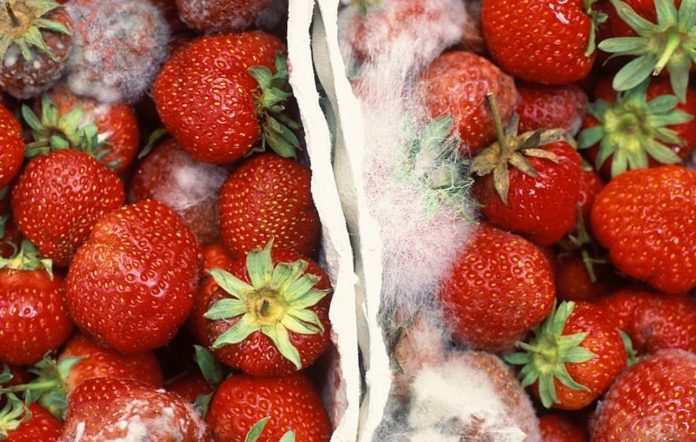When we see a mold (fungi) spot on the surface of a food, many times we are only seeing the tip of the iceberg. However, we have heard many people say that just by removing the infected part, the rest of the food is in optimal condition to be consumed. Is this true?
You must first know what mold is. They are microscopic fungi, with several filaments, where the vast majority produce spores. In fact, the spores are what give the mold its color. Unlike single-cell bacteria, mold is made up of many cells and can be seen with the naked eye.
- Brief Anger Hampers Blood Vessel Function Leading to Increased Risk of Heart Disease and Stroke – New Study
- New Blood Test Pinpoints Future Stroke Risk – Study Identifies Inflammatory Molecules as Key Biomarker
- Enceladus: A Potential Haven for Extraterrestrial Life in its Hidden Ocean Depths
- New Experiment: Dark Matter Is Not As ‘DARK’ As All We Think
- Scientists in Fear of This New Predator From Red Sea Eating Native Species in Mediterranean
Some types of mold can cause allergic reactions and respiratory problems. The types of mold found in red meat and poultry are: Alternaria, Aspergillus, Botrytis, Cladosporium, Fusarium, Geotrichum, Monilia, Manoscus, Mortierella, Mucor, Neurospora, Powdery mildew, Oosproa, Penicillium, Rhizopus and Thamnidium.
Although they can also be found in other foods.
Other types of mold, under certain circumstances, can produce dangerous substances called mycotoxins. Although most are found in grain and nut crops, they can be found in celery, grape juice, apples, and other foods.
The Food and Agriculture Organization (FAO) of the United Nations estimates that 25% of food crops worldwide are affected by mycotoxins, the worst being aflatoxins.
Aflatoxin is known to cause cancer and is mainly found during the peanut and corn harvest. This is why many government agencies monitor the production and harvest of these ingredients. Aflatoxins have been associated with various diseases, such as aflatoxicosis in livestock, pets, and humans.
However, it is possible to find certain fungi that have a benefit. For example, specific types of molds are used to make cheeses, such as Roquefort, blue quezo, Gorgonzola and Stilton, to which spores of P. roqueforti or Penicillium roqueforti are added.
Cheeses like Brie and Camembert have a white moldy surface. Other cheeses have mold on the inside and on the surface. But these types of molds are safe for human consumption.
To prevent mold growth, cleanliness is essential. Mold spores can accumulate on the refrigerator, dish towels, and other cleaning utensils. Clean the inside of the refrigerator every two months, remove with a little bleach the black mold that forms on the rubber covers of kitchen utensils, keep kitchen rags, towels, sponges and mops clean and fresh.
To keep food from getting moldy, cover all food containers. Always empty the leftovers into covered containers, and try to consume them within the next 3-4 days. If you come across a food that already shows signs of mold, don’t smell it, as we already mentioned, certain types of mold can cause respiratory problems.
- Brief Anger Hampers Blood Vessel Function Leading to Increased Risk of Heart Disease and Stroke – New Study
- New Blood Test Pinpoints Future Stroke Risk – Study Identifies Inflammatory Molecules as Key Biomarker
- Enceladus: A Potential Haven for Extraterrestrial Life in its Hidden Ocean Depths
- New Experiment: Dark Matter Is Not As ‘DARK’ As All We Think
- Scientists in Fear of This New Predator From Red Sea Eating Native Species in Mediterranean
If the food is completely covered in mold, put it in a plastic bag, seal it tightly, and throw it away in the organic trash. Clean very well where that food was, and check the food that was near it.
Mold is an indicator that the food has probably been stored for too long. Moldy foods can also have bacteria that are invisible to the naked eye.
So the recommendation is to discard foods that show signs of mold. The only exceptions are hard salami, which you can scrape off mold, hard cheeses, firm fruits and vegetables with low moisture content (carrots, peppers, etc.).
- Brief Anger Hampers Blood Vessel Function Leading to Increased Risk of Heart Disease and Stroke – New Study
- New Blood Test Pinpoints Future Stroke Risk – Study Identifies Inflammatory Molecules as Key Biomarker
- Enceladus: A Potential Haven for Extraterrestrial Life in its Hidden Ocean Depths
- New Experiment: Dark Matter Is Not As ‘DARK’ As All We Think
- Scientists in Fear of This New Predator From Red Sea Eating Native Species in Mediterranean
Image Credit: Getty
